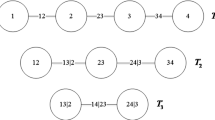Abstract
Many modern structural systems usually consist of multiple failure modes. One failure mode may affect other failure modes due to the same working environment and random input variables, meaning that these failure modes are not independent. The assumption of independence among failure modes simplifies the calculation of reliability of structural systems, but it adds approximation error. Different from the dependence between two failure modes, the dependence of multiple failure modes is more complicated. In this paper, on the basis of vine copula function, which is a flexible tool to describe the multivariate dependence, the dependence of multiple failure modes of the structural systems is mainly studied and analyzed. Then Rosenblatt transformation and Monte Carlo simulation method are utilized to evaluate the reliability of structural systems. Furthermore, in order to research the importance of failure modes, two indices combined with empirical copula functions are extended, which can quantitatively measure the importance of failure modes. The multiple failure modes can be ranked based on proposed importance analysis, and the ones that have greater influence on the system can be found out, thus simplifying the system analysis. Finally, in order to confirm the applicability and rationality of the proposed method, an engineering case about a mechanism system with five failure modes is presented.












Similar content being viewed by others
References
Park C, Kim NH, Haftka RT (2015) The effect of ignoring dependence between failure modes on evaluating system reliability. Struct Multidiscipl Optim 52:251–268. https://doi.org/10.1007/s00158-015-1239-7
Wei P, Liu F, Tang C (2018) Reliability and reliability-based importance analysis of structural systems using multiple response Gaussian process model. Reliab Eng Syst Saf 175:183–195. https://doi.org/10.1016/j.ress.2018.03.013
Kaintura A, Spina D, Couckuyt I et al (2017) A Kriging and Stochastic Collocation ensemble for uncertainty quantification in engineering applications. Eng Comput 33:935–949. https://doi.org/10.1007/s00366-017-0507-0
Khandelwal M (2011) Blast-induced ground vibration prediction using support vector machine. Eng Comput 27:193–200. https://doi.org/10.1007/s00366-010-0190-x
Li J, Chen J, Fan W (2007) The equivalent extreme-value event and evaluation of the structural system reliability. Struct Saf 29:112–131. https://doi.org/10.1016/j.strusafe.2006.03.002
Jia X, Shen J, Wang L, Li Z (2017) Vine copula constructions of higher-dimensional dependent reliability systems. Commun Stat Theory Methods 46:9126–9136. https://doi.org/10.1080/03610926.2016.1205620
Bichon BJ, McFarland JM, Mahadevan S (2011) Efficient surrogate models for reliability analysis of systems with multiple failure modes. Reliab Eng Syst Saf 96:1386–1395. https://doi.org/10.1016/j.ress.2011.05.008
Sadoughi M, Li M, Hu C (2018) Multivariate system reliability analysis considering highly nonlinear and dependent safety events. Reliab Eng Syst Saf 180:189–200. https://doi.org/10.1016/j.ress.2018.07.015
Li DQ, Zhang L, Tang XS et al (2015) Bivariate distribution of shear strength parameters using copulas and its impact on geotechnical system reliability. Comput Geotech 68:184–195. https://doi.org/10.1016/j.compgeo.2015.04.002
Zhang J, Ma X, Zhao Y (2017) A stress-strength time-varying correlation interference model for structural reliability analysis using copulas. IEEE Trans Reliab 66:351–365. https://doi.org/10.1109/TR.2017.2694459
Pan Z, Balakrishnan N, Sun Q, Zhou J (2013) Bivariate degradation analysis of products based on Wiener processes and copulas. J Stat Comput Simul 83:1316–1329. https://doi.org/10.1080/00949655.2012.658805
Peng W, Li Y-F, Yang Y-J et al (2016) Bivariate analysis of incomplete degradation observations based on inverse gaussian processes and copulas. IEEE Trans Reliab 65:624–639. https://doi.org/10.1109/TR.2015.2513038
Eryilmaz S (2014) Multivariate copula based dynamic reliability modeling with application to weighted-k-out-of-n systems of dependent components. Struct Saf 51:23–28. https://doi.org/10.1016/j.strusafe.2014.05.004
Bedford T, Cooke RM (2001) Probability density decomposition for conditionally dependent random variables modeled by vines. Ann Math Artif Intell 32:245–268. https://doi.org/10.1023/A:1016725902970
Bedford T, Cooke RM (2002) Vines–a new graphical model for dependent random variables. Ann Stat 30:1031–1068. https://doi.org/10.1214/aos/1031689016
Kurowicka D, Cooke R (2006) Uncertainty analysis with high dimensional dependence modelling. Wiley, Chichester, Hoboken
Aas K, Czado C, Frigessi A, Bakken H (2009) Pair-copula constructions of multiple dependence. Insurance Math Econ 44:182–198. https://doi.org/10.1016/j.insmatheco.2007.02.001
Xu D, Wei Q, Elsayed EA et al (2017) Multivariate degradation modeling of smart electricity meter with multiple performance characteristics via vine copulas: multivariate degradation modeling of SEM via vine copulas. Qual Reliab Eng Int 33:803–821. https://doi.org/10.1002/qre.2058
Jiang C, Zhang W, Han X et al (2015) A vine-copula-based reliability analysis method for structures with multidimensional correlation. J Mech Des 137:061405. https://doi.org/10.1115/1.4030179
Czado C (2019) Analyzing dependent data with vine copulas: a practical guide with R. Springer, Cham
Dutuit Y, Rauzy A (2015) On the extension of importance measures to complex components. Reliab Eng Syst Saf 142:161–168. https://doi.org/10.1016/j.ress.2015.04.016
Wei P, Lu Z, Song J (2014) Moment-independent sensitivity analysis using copula: moment-independent sensitivity analysis using copula. Risk Anal 34:210–222. https://doi.org/10.1111/risa.12110
Wei P, Lu Z, Song J (2015) Variable importance analysis: a comprehensive review. Reliab Eng Syst Saf 142:399–432. https://doi.org/10.1016/j.ress.2015.05.018
Zhou C, Lu Z, Ren B, Cheng B (2014) Failure-mode importance measures in system reliability analysis. J Eng Mech 140:04014084. https://doi.org/10.1061/(ASCE)EM.1943-7889.0000798
He L, Lu Z, Li Xinyao (2018) Failure-mode importance measures in structural system with multiple failure modes and its estimation using copula. Reliab Eng Syst Saf 174:53–59. https://doi.org/10.1016/j.ress.2018.02.016
Hohenbichler M, Rackwitz R (1982) First-order concepts in system reliability. Struct Saf 1:177–188. https://doi.org/10.1016/0167-4730(82)90024-8
Nelsen RB (2006) An introduction to Copulas, 2. ed. 2006. Springer New York
Joe H (1996) Families of m-variate distributions with given margins and m(m-1)/2 bivariate dependence parameters. In: Lecture notes-monograph series. Institute of Mathematical Statistics, Hayward, pp 120–141
Akaike H (1992) Information theory and an extension of the maximum likelihood principle. In: Kotz S, Johnson NL (eds) Breakthroughs in statistics. Springer, New York, pp 610–624
Aho K, Derryberry D, Peterson T (2014) Model selection for ecologists: the worldviews of AIC and BIC. Ecology 95:631–636. https://doi.org/10.1890/13-1452.1
Keshtegar B, Kisi O (2017) M5 model tree and Monte Carlo simulation for efficient structural reliability analysis. Appl Math Model 48:899–910. https://doi.org/10.1016/j.apm.2017.02.047
Zeng P, Li T, Chen Y et al (2019) New collocation method for stochastic response surface reliability analyses. Eng Comput. https://doi.org/10.1007/s00366-019-00793-2
Rosenblatt M (1952) Remarks on a multivariate transformation. Ann Math Statist 23:470–472. https://doi.org/10.1214/aoms/1177729394
Lebrun R, Dutfoy A (2009) A generalization of the Nataf transformation to distributions with elliptical copula. Probab Eng Mech 24:172–178. https://doi.org/10.1016/j.probengmech.2008.05.001
Wang F, Li H (2018) Distribution modeling for reliability analysis: impact of multiple dependences and probability model selection. Appl Math Model 59:483–499. https://doi.org/10.1016/j.apm.2018.01.035
Lebrun R, Dutfoy A (2009) An innovating analysis of the Nataf transformation from the copula viewpoint. Probab Eng Mech 24:312–320. https://doi.org/10.1016/j.probengmech.2008.08.001
Kuo W, Zuo MJ (2003) Optimal reliability modeling: principles and applications. Wiley, Hoboken.
Kuo W, Zhu X (2012) Importance measures in reliability, risk, and optimization: principles and applications. Wiley, Chichester
Guo W, Cui W, Shi Y et al (2016) Function failure and failure boundary analysis for an aircraft lock mechanism. Eng Fail Anal 70:428–442. https://doi.org/10.1016/j.engfailanal.2016.10.003
Shen L, Zhang Y, Song K, Song B (2019) Failure analysis of a lock mechanism with multiple dependent components based on two-phase degradation model. Eng Fail Anal 104:1076–1093. https://doi.org/10.1016/j.engfailanal.2019.06.035
Pang H, Yu T, Song B (2016) Failure mechanism analysis and reliability assessment of an aircraft slat. Eng Fail Anal 60:261–279. https://doi.org/10.1016/j.engfailanal.2015.11.032
Shu Zhen, Jirutitijaroen P (2011) Latin hypercube sampling techniques for power systems reliability analysis with renewable energy sources. IEEE Trans Power Syst 26:2066–2073. https://doi.org/10.1109/TPWRS.2011.2113380
Bowman AW, Azzalini A (1997) Applied smoothing techniques for data analysis: the kernel approach with S-Plus illustrations. Clarendon Press, Oxford University Press, New York, Oxford
Dissmann J, Brechmann EC, Czado C, Kurowicka D (2013) Selecting and estimating regular vine copulae and application to financial returns. Comput Stat Data Anal 59:52–69. https://doi.org/10.1016/j.csda.2012.08.010
Nagler T, Schepsmeier U, Stoeber J et al (2019) VineCopula: statistical inference of vine copulas, R package version 2.2.0. https://CRAN.R-project.org/package=VineCopula
Acknowledgement
This paper has been supported by Natural Science Foundation of China (Grant no. 51675428).
Author information
Authors and Affiliations
Corresponding author
Additional information
Publisher's Note
Springer Nature remains neutral with regard to jurisdictional claims in published maps and institutional affiliations.
Rights and permissions
About this article
Cite this article
Shen, L., Zhang, Y., Song, B. et al. Reliability evaluation and importance analysis of structural systems considering dependence of multiple failure modes. Engineering with Computers 38, 1053–1070 (2022). https://doi.org/10.1007/s00366-020-01100-0
Received:
Accepted:
Published:
Issue Date:
DOI: https://doi.org/10.1007/s00366-020-01100-0




